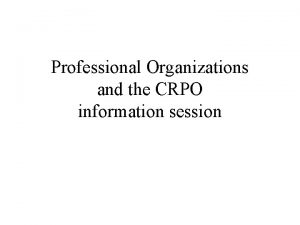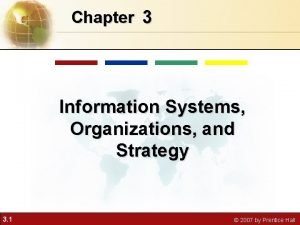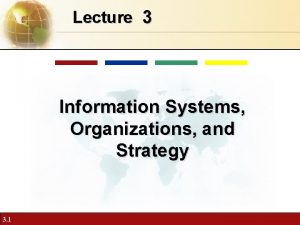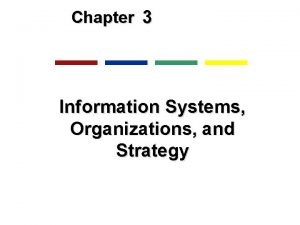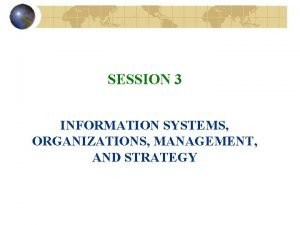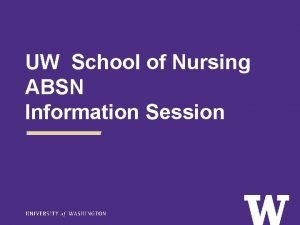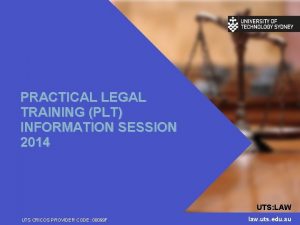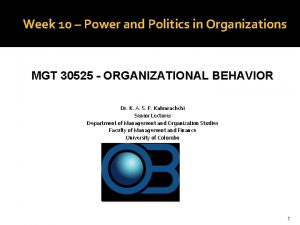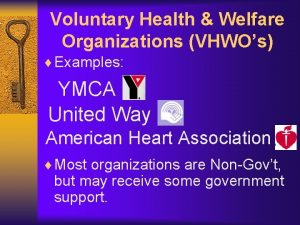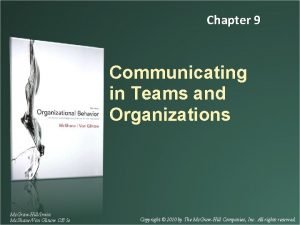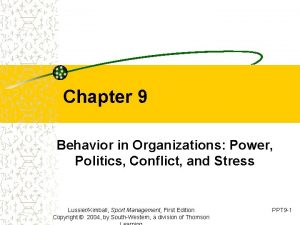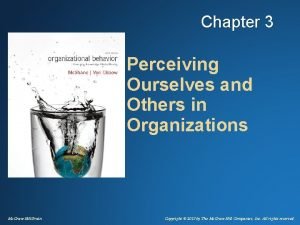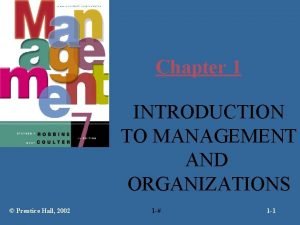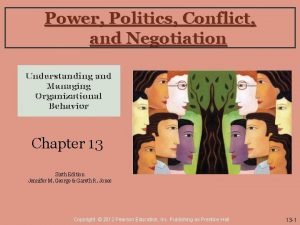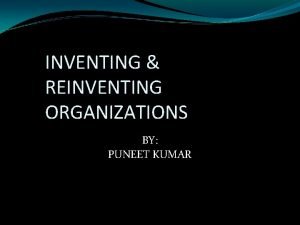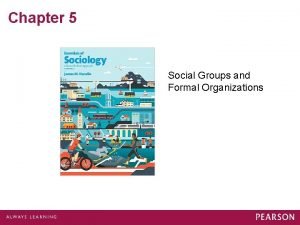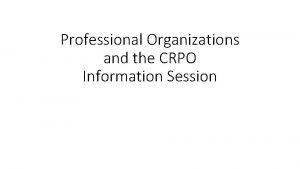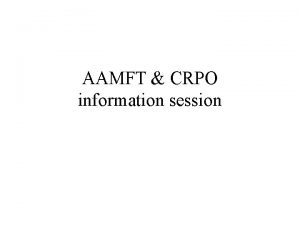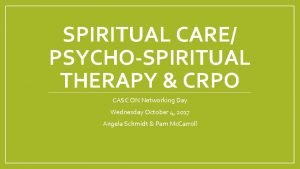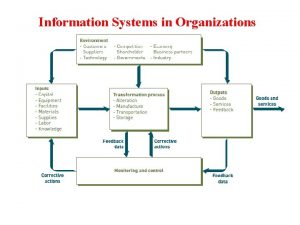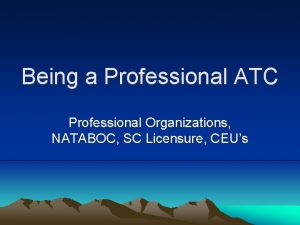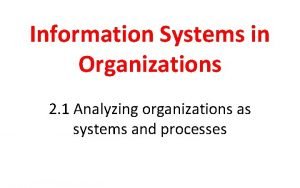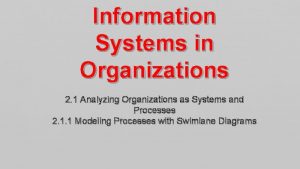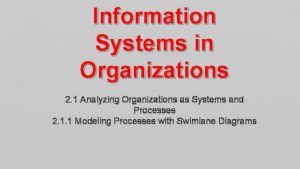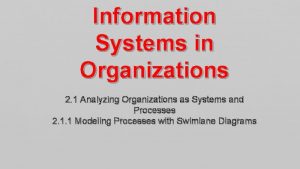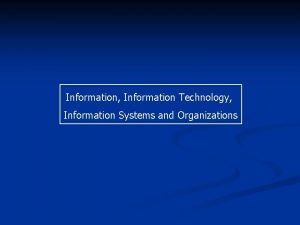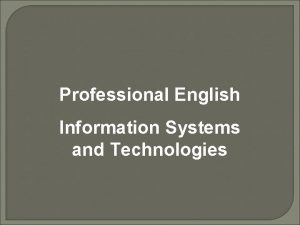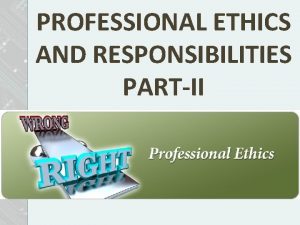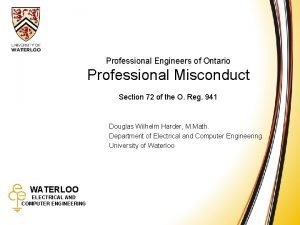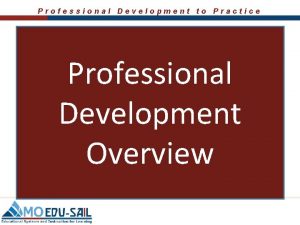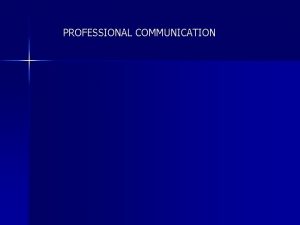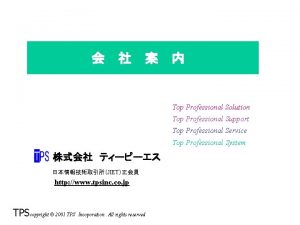Professional Organizations and the CRPO information session This

























































- Slides: 57

Professional Organizations and the CRPO information session

• This presentation can be found at: • http: //www. tyndale. ca/seminary/counselling/d ownloads/documents

Professional Organizations • AAMFT, CAMFT, OACCPP, etc. are all professional organizations instituted to protect the provider and offer services and training at better rates, and present a united voice for Marriage and Family Therapists and other health care providers. • I am going to talk about three today, AAMFT, OAMFT and CAMFT.

American Association for Marriage and Family Therapy • AAMFT, the professional organization that provided the most credibility to therapists practicing at the Masters level. • Requirements set at appropriate standards including training, and supervised internships. • With the advent of Provincial licensing, credibility is still important, but standards of the CRPO are, in fact, very similar to those of AAMFT.

• As of August 2017 the relationship between AAMFT (the American Association for Marriage and Family Therapy) and OAMFT (the Ontario Association for Marriage and Family Therapy) has changed dramatically • AAMFT has suspended all divisions • This means that OAMFT as we knew it no longer exists.

• The Executive of OAMFT have known about this possibility and have been working diligently to create a workable solution for Canadian Systems-Based Marriage and Family Therapists • The final solution has resulted in OAMFT remaining affiliated with AAMFT, but not as before.

• The OAMFT is now an International Independent Affiliate of the AAMFT, the American organization for individuals interested in the field of marriage and family therapy. • AAMFT provides a unified voice for many marriage and family therapists and is known internationally.

• OAMFT still provides services for providers and opportunities that focus on advocacy, education, and networking within Ontario. • To become a member of the OAMFT, you must register with the AAMFT and opt-in to International Independent Affiliate of Ontario to tailor your member benefits. • Membership requirements, then, are those of AAMFT.

• As an OAMFT member you are eligible to receive the services, resources, and conveniences provides by the AAMFT and additional benefits which include exclusive member discounts on products and services such as OAMFT courses, webinars, and the annual conference.

CAMFT • Canadian Association for Marriage and Family Therapy: • CAMFT holds property rights to the title RMFT. To have this designation, you must maintain or procure membership with CAMFT • CAMFT has recently set standards for membership very similar to AAMFT with only a few exceptions:

Exceptions: • Requires only 150 hours of face to face supervised practicum hours instead of 300 required by AAMFT. • Requires additional study of the Canadian issue of Residential Schools and the Truth and Reconciliation document.

• CAMFT is currently in the process of accrediting various training institutions and has invited Tyndale and some 7 other Canadian Universities and Seminaries to participate in setting these standards. • We believe that CAMFT will be more reasonable and sensitive to Canadian needs than we have found AAMFT to be.

What to do? • Our advice is to consider where you want to end up. • If your future is in the US or in some other non -Canadian situation, AAMFT probably is your most helpful organization. They are known internationally and may give you more credibility than Canadian organizations.

• If you are already a member of AAMFT, you may want to maintain your current AAMFT membership and continue to get courses approved through the existing AAMFT procedures. In all likelihood there will be a reciprocity clause in CAMFT procedures, although you may need to do the required indigenous studies component.

• For those who are not yet members of AAMFT, it might make sense to wait and see what the new Canadian system will be (CAMFT), and start the process with them. • As of now, both OAMFT and CAMFT are in existence and still organizing. You may check each website to see what is offered by each organization.

• Paul and I are involved in meetings with CAMFT and believe this organization will provide the most desirable membership for Canadians at the end of the day. And there is good reason to believe that Tyndale will be an accredited program with them very soon.

• None of this affects CRPO membership. AAMFT/OAMFT/CAMFT are all professional organizations and membership is wise but not required for practice. • Registration with the CRPO is required and unrelated to membership in a professional organization.

Steps towards AAMFT Clinical Fellow Designation (CAMFT very similar)

Membership Categories • • Student (Associate) Pre-Clinical Fellow

Clinical Fellow Membership Evaluative Requirements • Educational Requirements: Master or doctorate degree from an educational institution accredited by the Commission on Accreditation for Marriage and Family Therapy Education (COAMFTE). Or a master’s or doctoral degree in a related mental health field and substantially equivalent course of study from a regionally accredited educational institution or postgraduate training institute accredited by COAMFTE.

• Tyndale is not accredited by the Commission on Accreditation for Marriage and Family Therapy Education (COAMFTE) • Tyndale graduates must apply under the “evaluative track” • Each course must be approved and categorized by AAMFT • Keep a permanent copy of every syllabus of every counselling course • Keep a copy of all AAMFT correspondence

Curriculum Requirements • Marriage and Family Studies (a minimum of three courses required) 1. Family Systems 2. Cross-Cultural Perspectives 3. Gender and Socioeconomic

• Marriage and Family Therapy (a minimum of three courses required) 1. Theories and Methods of Family Therapy 1 2. Theories and Methods of Family Therapy 2 3. (need one elective) (currently Couples Therapy, EFT, and Child and Adolescent Therapy have been accepted in this category.

• Human Development (a minimum of three courses required) 1. Personality Theory 2. Current Issues in Psychopathology 3. (need one elective) (electives that could qualify: Human Development and Learning; Human Sexuality; Child and Adolescent therapy; Therapeutic and Systemic Approaches to Addictions; Violence in Relationships)

• Professional Ethics (a minimum of one course required) 1. Professional Ethics • Research (a minimum of one course required) 1. Research Methods • Total: 11 courses • CAMFT has added study (not a course) related to indigenous issues in Canada.

Practicum Requirement • Minimum one (1) year, supervised Clinical Fellow practicum, with 300 hours of direct client contact with individuals, couples, and families. • CAMFT has reduced this to 150 hours of direct client contact.

• Tyndale’s Internship only requires 150 face to face counselling hours • The other 150 hours can be accomplished after graduation (must be supervised by an AAMFT approved supervisor after graduation) • Once the total of 300 face-to-face Internship hours has been completed, one may begin to log the 1000 post-graduation hours

Post-Graduate Clinical Experience • Minimum of two (2) years of professional work experience in marriage and family therapy following receipt of master’s or doctorate degree. • Individuals must complete a minimum of 200 hours of supervision concurrently on 1, 000 hours of client contact in marriage and family therapy.

Steps to take • Once accepted into the Counselling Major one can apply for AAMFT student membership at any time • Typically around the end of first year is a good time to apply • Application can be done on-line • Once you become a member, keep your membership active

Advantages of membership • Pre-approval of courses within the categories • May have impact on future OAMFT or CAMFT membership. • Post-degree applications will be simpler if you have updated your file regularly

Tyndale Courses • http: //tyndale. ca/seminary/counselling/downlo ads/documents • AAMFT Clinical Membership - Evaluative Track • Not all Tyndale Counselling courses are accepted by AAMFT. • This file has a list of all of the courses that AAMFT has accepted in the past and the categories in which they are typically placed

AAMFT Contact Person • The current AAMFT contact person for students seeking to have courses pre-approved is Dorothy Bose: • Dbose@aamft. org • Turn-around time for requests to categorize courses is often two months or more (so start your process early!)

The College of Registered Psychotherapists of Ontario • http: //www. crpo. ca/

Controlled Act of Psychotherapy • The controlled act of psychotherapy has been proclaimed and is one of 14 "controlled acts" or healthcare activities which are restricted to members of certain regulated professions.

The RHPA defines the controlled act of psychotherapy as follows: • “Treating, by means of psychotherapy technique, delivered through a therapeutic relationship, an individual’s serious disorder of thought, cognition, mood, emotional regulation, perception or memory that may seriously impair the individual’s judgment, insight, behaviour, communication or social functioning. ”

CRPO Registration Categories • Qualifying Member • Registered Member – still under supervision • Registered Member – independent practice

Steps toward Registration

• Who is a “regular applicant”? All applicants are regular applicants, except those already registered in another province or territory, who are applying for registration in Ontario under labour mobility rules.

• In general, regular applicants are individuals who have recently completed graduate-level psychotherapy programs: either independent psychotherapy programs that require an undergraduate degree for admission, or university master’s programs.

They have completed: • their education and training program within one year immediately prior to application; or • their clinical experience requirement within the one year immediately prior to application; or • 750 currency hours within the three years immediately prior to application; or • upgrading activities approved by Registration Committee.

• Registration requirements for regular applicants In addition to meeting the general requirements for all applicants, regular applicants must complete the following:

• the Professional Practice & Jurisprudence e. Learning Module; • a “recognized” education and training program in psychotherapy • [Tyndale’s Mdiv Counselling Major Clinical Track has been recognized as meeting all of the academic requirements for CRPO]

Qualifying Members • Virtually all regular applicants will spend a period of time as a Qualifying Member, i. e. RP (Qualifying), until they are deemed eligible to write the registration exam and have successfully completed it. • To be eligible to write the exam, a Qualifying Member must have completed all education and training requirements for RP registration, but not necessarily all required direct client contact hours and clinical supervision hours.

Qualifying Members • When all requirements have been completed, the RP (Qualifying) will move to full RP status.

Qualifying Members • Individuals nearing completion of their education and training program can apply for registration as a Qualifying Member during the final semester/ segment of their program • An RP (Qualifying) will be required to practice with clinical supervision and must be actively engaged in completing registration requirements to become registered as an RP.

Qualifying Members • Have completed the Professional Practice & Jurisprudence e-Learning Module • Must be enrolled to take the registration exam, having successfully completed an education/training program that meets specific requirements

• Qualifying members will be permitted to use the titles: • Registered Psychotherapist (Qualifying) or • RP (Qualifying)

Registered Psychotherapists • 30 hours of competency development in safe and effective use of self (SEUS); normally included as part of an applicant’s education and training program; this can take the form of coursework, experiential learning, and/or personal psychotherapy focused on SEUS; • 450 direct client contact hours (can be part of the applicant’s education and training program and/or completed subsequently);

Registered Psychotherapists • 100 hours of clinical supervision; (a minimum of 50 hours of individual/dyadic supervision • successful completion of the registration exam, i. e. the national Assessment tool offered by the COMPASS Centre for Examination Development, a national body established to develop and administer the exam.

Registered Psychotherapists • Currency requirement: must have completed education/ training program, or clinical experience requirement, (450 client contact hours and 100 hours clinical supervision) within 12 months prior to application; OR completed 750 currency hours within previous 3 years

Currency Hours • direct client work • recordkeeping and preparation in relation to direct client work • professional development in psychotherapy • engaging in clinical supervision as a supervisee • conducting research or writing in the field of psychotherapy

Currency Hours • • • supervising teaching managing consulting other professional activities that impact the practice of psychotherapy.

Independent practice • RPs will not be permitted to practice independently, i. e. without clinical supervision, until they have completed 1000 direct client contact hours and 150 hours of clinical supervision over the course of their professional career. This limitation will apply to all Members and will remain in effect until the Member satisfies the College that they have completed the required hours.

Steps for CRPO membership • Graduate • Accrue 450 hours of direct client contact + 100 hours of supervision • Take Jurisprudence Exam • 30 hours of SEUS • Register to become a Member

• Take the Exam – become RP (Qualifying) • Finish direct client contact hours and supervision hours (RPs will not be permitted to practice independently, i. e. without clinical supervision, until they have completed 1000 direct client contact hours and 150 hours of clinical supervision over the course of their professional career). • Become an RP

Tyndale Electives to Consider • Therapy Interventions for Trauma, Abuse and violence (trauma issues) • Violence in Relationships (trauma issues) • Human Development and Learning (human development)

Safe & Effective Use of Self Category Alternate means of meeting this criteria • Personal Counselling • Use of assessment tools • Family system research • Increase understanding of one’s own cultural paradigms • Self reflection • Supervision
 Crpo direct client contact hours
Crpo direct client contact hours Information systems, organizations, and strategy
Information systems, organizations, and strategy Information systems, organizations, and strategy
Information systems, organizations, and strategy Information systems, organizations, and strategy
Information systems, organizations, and strategy Information systems organizations and strategy
Information systems organizations and strategy Chapter 3 information systems organizations and strategy
Chapter 3 information systems organizations and strategy Aka graduate information session
Aka graduate information session Absn seattle
Absn seattle Uts student admin
Uts student admin Wharton information session
Wharton information session Parent information session
Parent information session Professional issues in information security
Professional issues in information security Power and politics in organizations
Power and politics in organizations Vhwo
Vhwo Floral shops bookstores and farms are examples of
Floral shops bookstores and farms are examples of Formal groups fulfill both and functions in organizations.
Formal groups fulfill both and functions in organizations. Persuasive communication
Persuasive communication Power, politics and conflict in organizations
Power, politics and conflict in organizations Perceiving ourselves and others in organizations
Perceiving ourselves and others in organizations Introduction to management chapter 1
Introduction to management chapter 1 Csusm clubs and organizations
Csusm clubs and organizations Power, politics and conflict in organizations
Power, politics and conflict in organizations Threshold limit value of ammonia
Threshold limit value of ammonia Inventing and reinventing organizations
Inventing and reinventing organizations Cultures and organizations software of the mind
Cultures and organizations software of the mind Social groups and formal organizations
Social groups and formal organizations Hình ảnh bộ gõ cơ thể búng tay
Hình ảnh bộ gõ cơ thể búng tay Frameset trong html5
Frameset trong html5 Bổ thể
Bổ thể Tỉ lệ cơ thể trẻ em
Tỉ lệ cơ thể trẻ em Gấu đi như thế nào
Gấu đi như thế nào Tư thế worms-breton
Tư thế worms-breton Chúa sống lại
Chúa sống lại Môn thể thao bắt đầu bằng từ đua
Môn thể thao bắt đầu bằng từ đua Thế nào là hệ số cao nhất
Thế nào là hệ số cao nhất Các châu lục và đại dương trên thế giới
Các châu lục và đại dương trên thế giới Công thức tính thế năng
Công thức tính thế năng Trời xanh đây là của chúng ta thể thơ
Trời xanh đây là của chúng ta thể thơ Mật thư anh em như thể tay chân
Mật thư anh em như thể tay chân Phép trừ bù
Phép trừ bù Phản ứng thế ankan
Phản ứng thế ankan Các châu lục và đại dương trên thế giới
Các châu lục và đại dương trên thế giới Thơ thất ngôn tứ tuyệt đường luật
Thơ thất ngôn tứ tuyệt đường luật Quá trình desamine hóa có thể tạo ra
Quá trình desamine hóa có thể tạo ra Một số thể thơ truyền thống
Một số thể thơ truyền thống Bàn tay mà dây bẩn
Bàn tay mà dây bẩn Vẽ hình chiếu vuông góc của vật thể sau
Vẽ hình chiếu vuông góc của vật thể sau Biện pháp chống mỏi cơ
Biện pháp chống mỏi cơ đặc điểm cơ thể của người tối cổ
đặc điểm cơ thể của người tối cổ Thế nào là giọng cùng tên?
Thế nào là giọng cùng tên? Vẽ hình chiếu đứng bằng cạnh của vật thể
Vẽ hình chiếu đứng bằng cạnh của vật thể Fecboak
Fecboak Thẻ vin
Thẻ vin đại từ thay thế
đại từ thay thế điện thế nghỉ
điện thế nghỉ Tư thế ngồi viết
Tư thế ngồi viết Diễn thế sinh thái là
Diễn thế sinh thái là Dot
Dot
